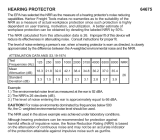
Warranty
Etymotic will repair or replace defective product
at its option if returned within one year of purchase
to our designated service facility. This warranty is
in lieu of all other warranties, expressed or implied,
including, but not limited to, any implied warranty
of merchantability or fitness for a particular purpose.
Noise
Reduction
Rating
DECIBELS
25
(WHEN USED AS DIRECTED)
THE RANGE OF NOISE REDUCTION RATINGS
FOR EXISTING HEARING PROTECTORS
IS APPROXIMATELY 0 TO 30
(HIGHER NUMBERS DENOTE GREATER EFFECTIVENESS)
ETYMOTIC RESEARCH, INC.
ELK GROVE VILLAGE, IL 60007
LABEL REQUIRED BY
U.S. E.P.A. REGULATION
40 CFR Part 211, Subpart B.
Federal law prohibits
removal of this label
prior to purchase.
GSP15-BN
EPA
ER098630-B ETYMOTIC RESEARCH INC.
61 Martin Lane
•
Elk Grove Village, IL 60007
©2014. AccuFit and AccuFilters are trademarks of Etymotic Research, Inc.
ETYMOTIC, GunSport•PRO and ACCU•Technology are registered trademarks of Etymotic Research, Inc.
Frequency (Hz) 125 250 500 1000 2000 4000 8000
Mean Attenuation (dB) 25.3 24.0 24.3 25.6 29.6 32.5 34.8
Standard Deviation (dB) 5.9 4.6 5.6 4.8 3.3 3.8 4.0
APV (dB) 19.4 19.5 18.8 20.9 26.3 28.7 30.8
H = 26 dB M = 21 dB L = 20 dB SNR = 25 dB
Active Attenuation - Criterion Levels
Switch position H-noise M-noise L-noise
LO 102 97 88
HI
88 89 86
H: Average attenuation characteristics in the high frequency spectrum (> 2 kHz)
M: Average attenuation characteristics in the mid frequency spectrum (0.5-2 kHz)
L: Average attenuation characteristics in the low frequency spectrum (< 0.5 kHz)
SNR (Single Number Rating): Average attenuation characteristics in the standard frequency spectrum
The European Union testing was conducted by:
Central Institute for Labour Protection—National Research Institute (CIOP-PIB)
ul Czerniakowska 16, 00-701 Warsaw, Poland. Notified Body No. 1437.
This product is in compliance with EN 352-2:2002 and EN 352-7:2002.















